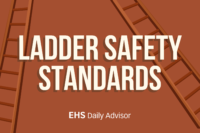In all workplaces, it is critical to have signs, tags, and labels to point out potential hazards. OSHA has clear guidelines on how to use signs and tags to help prevent accidents for workers, the public, or both. Signs and tags are also important to avoid property damage. OSHA’s guidelines are meant to cover all safety signs […]
Ladders are an integral piece of equipment in many industries and workplaces, but they also are a major hazard if not used properly. According to OSHA, falls from portable ladders are one of the leading causes of occupational deaths and injuries. Here’s what you need to know about OSHA’s ladder safety standards. Check out our Back to […]
In recent years, EHS leaders have been shifting focus towards becoming more sustainable and embracing concepts such as Environmental, Social, and Governance (ESG). The social component of ESG aims to bring subjects to the table that in the past would have been handled by the human resources (HR) department, such as diversity, equity, and inclusion […]
In the midst of the ongoing pandemic, a lot of attention has been called to personal protective equipment (PPE), both in the general public and in the workplace. However, PPE has been required in many types of industries for years, and it is important for environmental, health, and safety (EHS) leaders to understand PPE standards. […]
All environmental, health, and safety (EHS) leaders should be familiar with the term “toolbox talks,” which can also be known by many other names, such as safety briefings, pre-start, take 5 safety talks, or tailgate safety meetings. Toolbox talks are the quick five- to 10-minute safety discussions held before the start of the workers’ shifts […]
In the workplace, one of the environmental, health, and safety (EHS) professional’s first priorities is ensuring daily on-the-job safety. However, another important aspect of an EHS leader’s job is to be prepared for what happens when external disasters strike. These could include anything from natural disasters like floods or earthquakes, cybersecurity issues or power outages, […]
The modern workplace is changing because of many different factors, including the COVID-19 pandemic, the Great Resignation, and younger generations entering the workforce. Employees are demanding more from companies, in terms of what the company can do for them, and within a broader social context. To deal with this shift in values, employers are turning […]
The Occupational Safety and Health Administration (OSHA) requires employers to comply with their training requirements in the workplace, which can include both initial training and refresher training that must take place annually.
Bloodborne pathogens are a dangerous hazard that can affect employees in many different kinds of work environments. According to OSHA, the CDC estimates that 5.6 million healthcare workers and employees in related fields are at risk of exposure to bloodborne pathogens through occupational exposure to blood or other potentially infectious materials (OPIM). Here’s what you […]
As it gets colder outside, it is important to revisit the safety measures that employers can take to make sure that all of their personnel remain safe this winter. Here’s what you need to know to protect your workforce from the dangers of cold stress.










